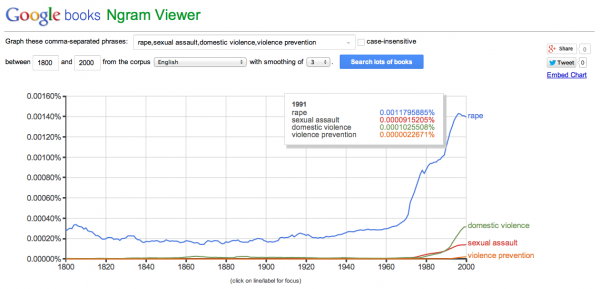*** DISCLAIMER: the following post features quoted text which contains offensive language and violent situations. I’m including the quoted text not to arouse or exploit but because in confronting misogyny in our culture and working to end violence I believe it is very important to quote the perpetrators and analyze it ***
We have it slightly luckier here in this country; all we have to contend with is Grand Theft Auto [wikipedia], what with its depictions of prostitutes and murder and theft and so on. Well, all of this seems a bit tame in comparison to what one Japanese software vendor is peddling.
I have done anti-violence work for the last seventeen years (and counting); I have seen or read or heard things that really challenge at times the sense of hope I try to hold for the human race. The depths of degradation – the intensity of the violence, the harshness of the language, the blatant misogyny – can be astounding. After all these years, I thought I’d seen it all. I was wrong.
From last week’s British Telegraph, courtesy of the Prevent-Connect listserv, an article about a video game being pulled from Amazon.com (thankfully) by a Japanese game-maker called Illusion, called “Rapelay”. From the article:
In Rapelay, gamers direct a character to sexually assault a mother and her two young daughters at an underground station, before raping any of a selection female characters.
Ahem.
Further, if your stomach isn’t already doing flip-flops, various video game sites refer to this title, and other absurd offerings from the same company, in straight-forward language, as if describing game-play where players choose to rape any number of female characters is no different than a player, say, selecting from among a series of furnishings for their Sim home, or choosing one of several different maps or locations to play in. To wit [courtesy of GiantBomb.com]:
Introduction:
RapeLay is a 3D “rape simulator” by Illusion Soft, makers of the Artificial Girl series. The player takes the role of a rapist who stalks a mother of two named Yuuko Kiryuu for a while and eventually rapes her.  Once he is “done” with the mother, the rapist gets his hands on Yuuko’s two daughters, Aoi and Manaka.
Gameplay:
Rapelay’s gameplay is divided in three main parts:
- Phase one
The games begins with the player following the victim on the train station. In this first phase one of the few thing you can do is pray the gods for a quick squall of winds that will blow up the victims skirt.Â
- Phase two
Once on the train the actual groping start, once the victim aroused the train will stop and the next phase of the game begins.
- Phase three
The third and final phase of every scene is the actual rape scene NPC [non-player characters -ed.] rapers can be called in to participate in the event. The location in which this happens varies with the victims. The actual location of the rape depends on the characters being raped. Yuuko’s location is the park, Aoi gets raped in a bathroom and Manaka in her bed room.
And it goes on from there.
The casualness of the language, the manner in which it is written – as if it’s merely technical writing describing the way a piece of software, or a microwave, works – offends me no end. It puzzles the mind that human beings exist that can so blatantly co-opt violence in order to make a buck selling a video game, without any comprehension of the reality of the impact of violence on women. This is the crux of the issue when it comes to ending sexual assault and dating violence: the actions have become so normalized that they are portrayed in video games (and movies, and music, and tv) as if they are valid behavioral choices. We need to re-draw the line; you know, that line you don’t cross. Re-draw it in bright, flashing neon.
Illusion’s web site is unfortunately in Japanese and yields little detail in terms of contact information (at least to this English speaking visitor). I am intending to do some sort of formal follow up – even if it’s just a letter of protest (though perhaps a petition is more called for); please stay tuned…
By the way, if you have an interest in violence prevention, and are curious about other un-believable examples of rape culture language in advertising and pop-culture media, when I find things I try to post them to the Men Stopping Rape blog at Tumblr:Â http://menstoppingrape.tumblr.com/.

